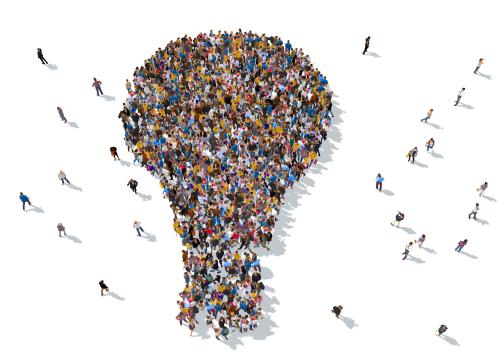The authors welcome thoughtful feedback and engagement from readers. Comments and responses may be directed to Jacob Taylor via [email protected].
This post is a product of an experimental new way of working with artificial intelligence (AI) that we are calling “vibe teaming” (see a recent working paper and summary blog for details). Vibe teaming brings together domain and AI skills. The domain skills build on several decades working on economic and political strategies for global poverty eradication. The AI skills help capture, organize, and iterate on team conversations in near-real time, enabling us to concentrate on framing the problem, surfacing strategic insights, and testing solutions together.
We started by postulating that the challenge of eradicating extreme poverty today is fundamentally different from what it was between 1990 and the early 2000s when raising economic growth in poor countries was the dominant paradigm. Today, ending poverty demands a combination of new technologies and new ways of thinking and working together across disciplines, institutions, and geographies. A single 90-minute vibe teaming session produced a full strategy brief for ending extreme poverty globally. We then worked with our customized AI model to convert that strategy into a commentary proposing a new paradigm for ending extreme poverty globally. The commentary was edited to adjust for style, factual accuracy, and referencing. Our objective here is not to offer new solutions but to show the promise of new approaches using AI.
We believe that tackling the world’s toughest challenges—from extreme poverty to climate change—depends not just on better knowledge, but on better ways of generating, sharing, and acting on knowledge together. Bringing together insights from multiple perspectives is widely seen as desirable but is practically unwieldy. Using AI could be a way of getting more voices, including the voices of beneficiaries through interviews, into policy debates in a novel and relatively inexpensive way. While we have not yet done so, adding more voices would be the logical next step. The total time to produce the commentary below was under five hours for the three of us combined. Our guess is that this is at least a 10x time saving compared to a traditional approach. It suggests that a broader application is feasible and practical.
A new paradigm for ending extreme poverty globally1
In the early 2000s, the global effort to reduce extreme poverty followed a clear formula: promote broad-based economic growth, enable structural transformation, and support countries to deliver better services. That approach worked astonishingly well. From 1990 to 2015, the world lifted over 1 billion people out of extreme poverty, thanks in large part to rapid economic growth in China, India, and Southeast Asia.
But that era is over. Today, the challenge has fundamentally changed and so have the solutions to address it. As of 2024, roughly 700 million people still live in extreme poverty—defined as living under $2.15 per day in 2017 purchasing power parity (PPP). These remaining poor people are not spread evenly across the globe. They are concentrated in countries or subnational regions, such as northern Nigeria, where growth has slowed or stopped, often due to fragility, conflict, or political dysfunction. They live in rural communities with weak infrastructure, in peri-urban slums beyond the reach of services, and in regions where social safety nets barely function. In many of these places, the prospects for growth itself are limited.
Eradicating extreme poverty globally requires a new strategy—one built not just on economic productivity, but on new technologies, country-led efforts, and clarity on the moral imperative to end poverty within a decade.
What’s off track and why
The world is not failing to reduce poverty because we lack the tools. In fact, now more than ever, tools like the World Poverty Clock and advances in geospatial modeling allow us to identify “poverty hotspots” at subnational levels—even down to the district or village.
We are failing because we are not using the right mindset. Much of the orthodoxy around poverty persists from a previous era. There remains deep skepticism among some donors and policymakers about the idea of simply giving poor people money. Concerns about corruption, dependency, and waste persist, despite a large and growing evidence base showing that unconditional direct cash transfers (DCTs) are among the most effective and efficient anti-poverty tools available. DCTs are increasingly recognized as proven interventions with low administrative overhead and consistently positive results.
Meanwhile, many governments remain stuck in fragmented delivery systems, unable or unwilling to reallocate resources toward the poorest areas. In countries like Nigeria, for example, poverty is heavily concentrated in the north—yet redistributive programs are often blocked by federal political structures designed to preserve equilibrium, not to maximize equity.
Ultimately, the people we’ve left behind are not hard to help—they’re just easy to ignore. Ending poverty today is less about finding new technologies or larger budgets and more about letting go of outdated assumptions—about who we trust, how we define fairness, and what kind of future we believe is possible.
A package to finish the job
If we are serious about ending extreme poverty by 2030—or soon thereafter—the international development community should rally around a more practical, trust-based strategy. This strategy should rest on five core interventions, each designed to address a distinct constraint:
1. Global scale-up of unconditional digital cash transfers
These are direct payments, delivered digitally or via mobile systems, prioritized to women and the most vulnerable. Advances in digital public infrastructure (DPI) make it possible to target beneficiaries more precisely and at lower cost than ever before. The real challenge now is not technical—it is political and philosophical. Do we trust poor people to decide for themselves how best to improve their lives? For instance, GiveDirectly, a nonprofit that provides unconditional cash transfers to families in extreme poverty, estimates the theoretical amount needed to move everyone below the extreme poverty line above it is approximately $100 billion per year for 10 years. While the practical cost of reaching everyone would likely be higher, this figure is just 0.1% of global income and well within the total Official Development Assistance spend of $258.7 billion in 2023.
2. Resilient rural opportunity zones (ROZs)
In areas with agricultural or artisanal potential, governments and development partners can support “zones of specialization”—clusters that receive coordinated investment in inputs, processing, marketing, and extension services. But for specialization to succeed, these zones must be backed by robust safety nets that allow people to take productive risks.
3. Community-delivered employment guarantees
Building on models like India’s MGNREGS, locally administered public works programs can provide income support while improving infrastructure and ecosystem resilience. In fragile settings, these could be implemented not through central government systems, but by community-based organizations and civil society groups.
4. Enterprise enablement grants
Small grants paired with coaching and mentorship can unlock entrepreneurship at the base of the economic pyramid—especially for women and youth in informal sectors. These programs are not about formalizing every microbusiness, but about recognizing and supporting the economic energy that already exists in poor communities. For example, the 4Afrika initiative focused on improving digital access and supporting innovation in Africa.
5. Nutrition and vaccine top-ups in fragile settings
In places where state capacity is compromised or contested, we must design delivery mechanisms that bypass the state without undermining it. This includes leveraging humanitarian DPI, working with U.N. agencies, and empowering trusted NGOs to deliver fortified foods, nutrition supplements, vaccines, and other essential services at scale—especially for mothers and children.
What it will cost—and why it’s worth it
The estimated investment to deliver this package is $300-400 billion over five years. This figure reflects the rough cost of using cash transfers to end extreme poverty, with a margin to cover complementary interventions like jobs, infrastructure, and delivery systems. It is achievable and proportionate. For perspective, in 2024, world military spending was more than $2.7 trillion while households spent $151 billion on pet food globally. Surely a system designed to end extreme poverty—not just manage it—could attract the necessary level of philanthropy.
| Share* | Funders | Implementers | |
| 1. Unconditional cash transfers | 40% | Governments, multilaterals | Govts, NGOs, mobile operators |
| 2. ROZ infrastructure | 20% | MDBs, IFAD | Local govts, cooperatives |
| 3. Employment schemes | 15% | Climate/job funds | CSOs, local govts |
| 4. Enterprise grants | 10% | Philanthropy, challenge funds | NGOs, incubators |
| 5. DPI + Fragility delivery | 15% | U.N., pooled funds | UNHCR, UNICEF, CSOs |
*To optimize impact and feasibility, 40% of investment goes to unconditional cash transfers for their proven effectiveness and scalability. Rural Opportunity Zones receive 20% to boost local productivity, while 15% supports employment schemes vital in fragile states. Enterprise grants (10%) aid informal entrepreneurs, and 15% funds delivery systems essential in low-capacity settings.
Of course, funding is only part of the picture. What’s missing is globally coordinated architecture. To this end, a proposal has recently been put forward to create a new, global-scale, purpose-driven fund to support the dramatic expansion of DCTs by backing country-led strategies, verifying results, and empowering the most credible delivery agents, whether public or non-state.
The proposed fund could help initiate a new approach to building durable systems that last. These systems will require meaningful incentives for governments to launch national poverty compacts and governance arrangements that prioritize fairness, flexibility, and local legitimacy from the ground up.
The core aim should be fixing the failure of our systems to learn and adapt, and to return agency to those who have too long been sidelined by technocratic control. The data is clear, the tools are ready, and the delivery models exist. What remains is a question of moral courage. Do governments and bureaucrats in rich economies and international development agencies trust poor people enough to give them control over their own destinies?
-
Footnotes
- This strategy was generated through a process of vibe teaming, which included the use of ChatGPT, a generative AI tool developed by OpenAI. The AI tool was used in April 2025 to assist to synthesize expert analysis and produce an initial draft. All final content was reviewed revised by the author(s) for factual accuracy and plagiarism prior to publication.
The Brookings Institution is committed to quality, independence, and impact.
We are supported by a diverse array of funders. In line with our values and policies, each Brookings publication represents the sole views of its author(s).





Commentary
Vibe teaming to end extreme poverty globally
June 17, 2025